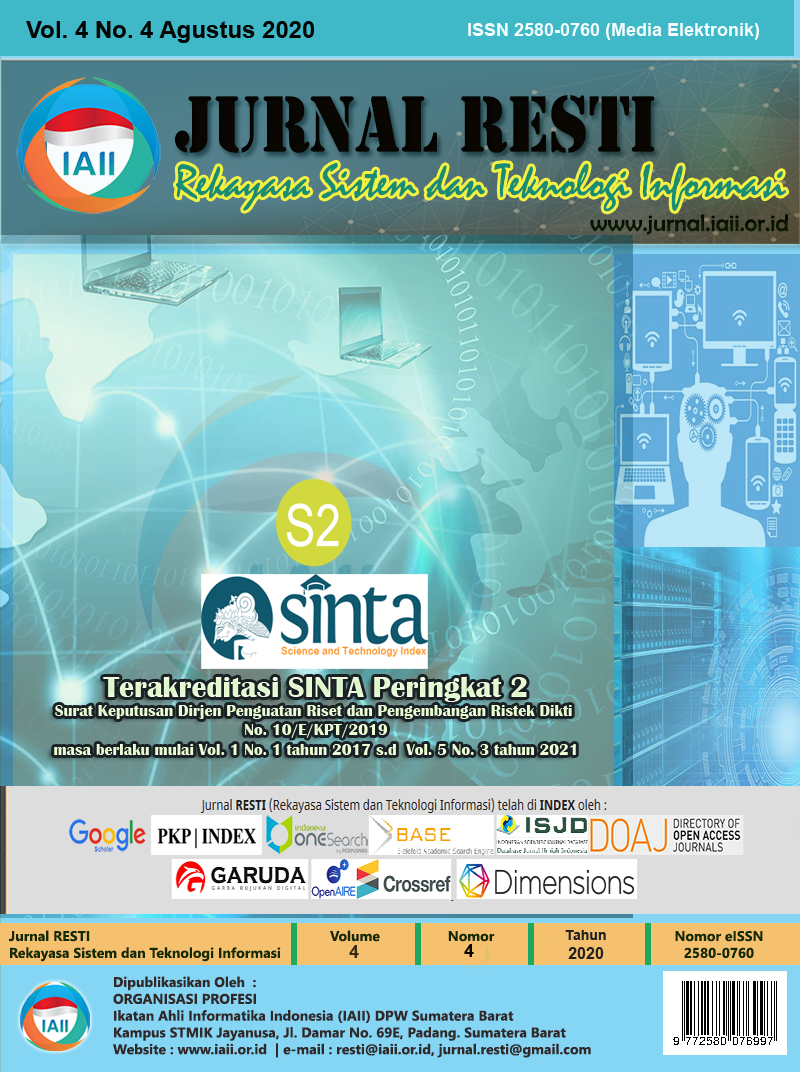Development of Virtual Reality Applications with the ADDIE Model for Prospective Educators of Children with Autism
Pengembangan Aplikasi Virtual Reality dengan Model ADDIE untuk Calon Tenaga Pendidik Anak dengan Autisme
Abstract
Knowledge is needed for children with special needs to support their quality of life. This is a challenge for prospective educators / prospective teachers. A deeper knowledge is needed to really understand children with special needs. This research is carried out to develop a skill simulator application for autistic child’s prospective educator using Virtual Reality technology. This application will be used as a teaching medium which incorporates motion sensor tools. The sensors will make the virtual application looks realistic. The application was developed using the ADDIE method (Analysis, Design, Development, Implementation and Evaluation). The application development begins with discovering the characteristic of autistic children. This is done to formulate the learning materials. The knowledge base of the autistic children was obtained from the Sekolah Luar Biasa (SLB). By using the obtained knowledge, storyboard was designed and implemented. The developed application has been evaluated by 16 prospective child educators with autism and two professional experts. In general, the application can help prospective educators understand the characteristics of children with autism. Moreover, it provides a safe and pleasant teaching skill practice for the prospective educators.
Downloads
References
C. Dugger, “The Effects of Early Intervention on Children with Autism Spectrum Disorder,” in Research Paper, 2012, p. 29, [Online]. Available: http://opensiuc.lib.siu.edu/gs_rp%0Ahttp://fisherpub.sjfc.edu/education_ETD_masters%5Cnhttp://opensiuc.lib.siu.edu/gs_rp/206.
L. Koegel, R. Matos-Freden, R. Lang, and R. Koegel, “Interventions for Children With Autism Spectrum Disorders in Inclusive School Settings,” Cogn. Behav. Pract., vol. 19, no. 3, pp. 401–412, 2012, doi: 10.1016/j.cbpra.2010.11.003.
J. B. Ganz, “Interventions for Autism Spectrum Disorders,” Iowa, 2014. doi: 10.1002/9781118660584.ese1263.
N. C. for S. E. R. (ED), “Summary of Autism Spectrum Disorders Research, FY 2006-FY 2015.,” 2015. [Online]. Available: http://eric.ed.gov/?q=asd+symptoms&pr=on&ft=on&id=ED560814.
T. M. Anggriana and R. P. Trisnani, “Kompetensi Guru Pendamping Siswa Abk Di Sekolah Dasar,” J. Konseling Gusjigang, vol. 2, no. 2, pp. 157–164, 2016, doi: 10.24176/jkg.v2i2.702.
S. Parsons and S. Cobb, “State-of-the-art of virtual reality technologies for children on the autism spectrum,” Eur. J. Spec. Needs Educ., vol. 26, no. 3, pp. 355–366, 2011, doi: 10.1080/08856257.2011.593831.
P. Kenny and T. D. Parsons, “Intelligent Virtual Patients for Training Clinical Skills,” J. Virtual Real. Broadcast., vol. 8, no. 3, 2011.
K. Vince, E. Vasquez III, and C. Pearl, “Efficacy of Individualized Clinical Coaching in a Virtual Reality Classroom for Increasing Teachers’ Fidelity of Implementation of Discrete Trial Teaching,” Div. Autism Dev. Disabil., vol. 47, no. 4, pp. 502–515, 2016, [Online]. Available: http://www.jstor.org/stable/23879642.
D. W. Fraser, “Using A Virtual Reality Environment to Train Special Educators Working with Students With Autism Spectrum Disorders To Implement Discrete Trial Teaching,” pp. 1–152, 2015.
O. Halabi, S. A. El-Seoud, J. M. Aljaam, H. Alpona, M. Al-Hemadi, and D. Al-Hassan, “Design of immersive virtual reality system to improve communication skills in individuals with autism,” Int. J. Emerg. Technol. Learn., vol. 12, no. 5, pp. 50–64, 2017, doi: 10.3991/ijet.v12i05.6766.
J. Oddsóttir, T. Þ. Sigurðardóttir, and K. R. Jóhannsdóttir, “Virtual Training for Discrete Trial Trainers,” no. September, 2016.
G. I. Valdimarsson, “Teaching Discrete Trial Training in Virtual Reality,” pp. 1–25, 2017.
J. Jeuring, R. van Rooij, and N. Pronost, “The 5/10 method: A method for designing educational games,” in Games and Learning Alliance, vol. 8605, A. De Gloria, Ed. Springer, Cham, 2014, pp. 364–369.
S. W. Jerdan, M. Grindle, H. C. Van Woerden, and M. N. Kamel Boulos, “Head-mounted virtual reality and mental health: Critical review of current research,” Journal of Medical Internet Research. 2018, doi: 10.2196/games.9226.
F. D. Davis, “Perceived usefulness, perceived ease of use, and user acceptance of information technology,” MIS Q. Manag. Inf. Syst., vol. 13, no. 3, pp. 319–339, 1989, doi: 10.2307/249008.
Copyright (c) 2020 Jurnal RESTI (Rekayasa Sistem dan Teknologi Informasi)

This work is licensed under a Creative Commons Attribution 4.0 International License.
Copyright in each article belongs to the author
- The author acknowledges that the RESTI Journal (System Engineering and Information Technology) is the first publisher to publish with a license Creative Commons Attribution 4.0 International License.
- Authors can enter writing separately, arrange the non-exclusive distribution of manuscripts that have been published in this journal into other versions (eg sent to the author's institutional repository, publication in a book, etc.), by acknowledging that the manuscript has been published for the first time in the RESTI (Rekayasa Sistem dan Teknologi Informasi) journal ;








